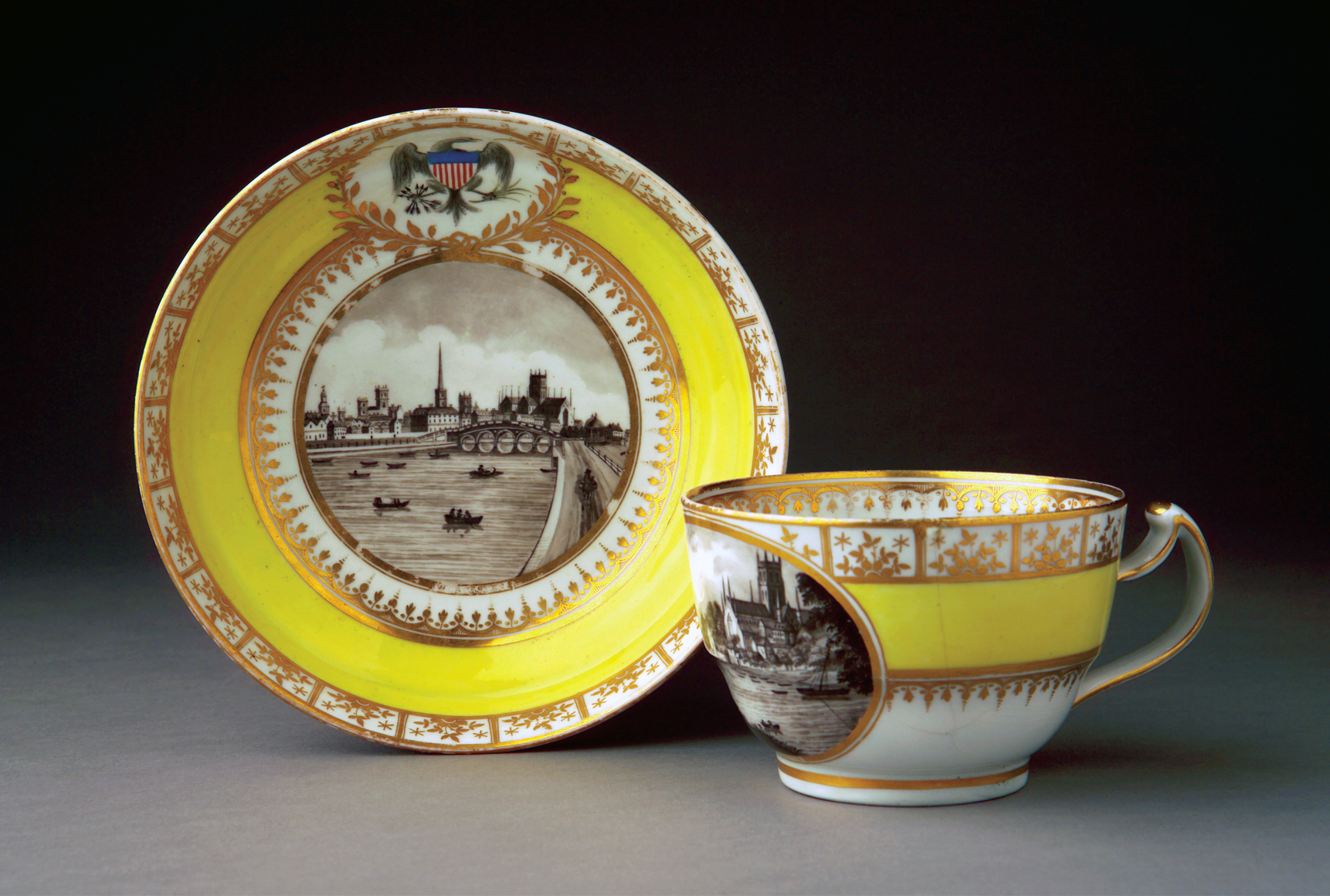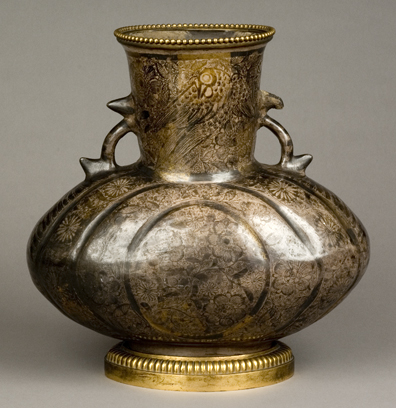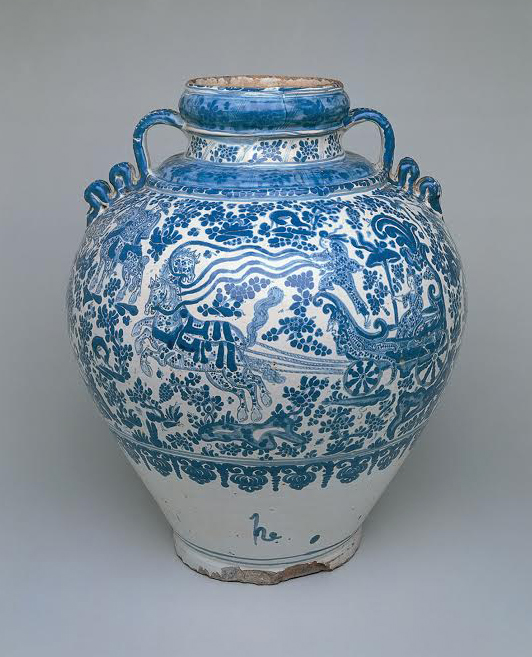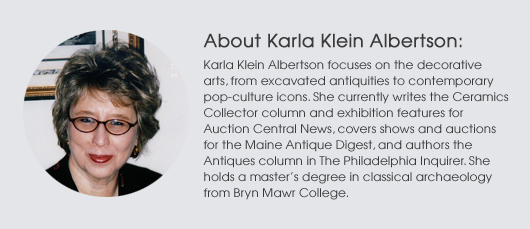
WINTERTHUR, Del. – Today we have worldwide trade in electronics, but in the past, the focus was on the worldwide trade in fashionable ceramics. No one gives a second thought to the long journey his flat screen television made from factory to living room. But imagine the perilous 18th century journey on the high seas that George Washington’s Chinese Export porcelain survived between its source half way around the world and the president’s table.
The annual Winterthur Ceramics Conference at the celebrated museum in Delaware is an extremely valuable educational resource for collectors and scholars alike. The 2015 event embraced the world trade theme: “This year’s conference focuses on ceramics that were marketed internationally – from China to the United States to Mexico and beyond. Upon arrival, some of these world-traveling vessels and dishes, in turn, inspired the creation of new wares.”
Held April 23-24, the conference presents two days of lectures by specialists from Winterthur and outside institutions as well as hands-on workshops where everyone has a chance to examine objects up close. In between, participants can meet and put questions directly to the experts and share information with other collectors in a convivial setting – in other words, networking for ceramics enthusiasts.
In any discussion of international trade, the conversation usually begins with Chinese Export porcelain; the wares had immense visual appeal and technological superiority. As the conference objective notes, their popularity with the public – from Royals to the merchant class – inspired firms in England, Europe, and the Americas to replicate and innovate; every pottery attempted to duplicate the strong white fabric and delicate designs of Asian wares.
English porcelain manufacturers competed for sales to the new United States. Note the American shield on the border of a cup and saucer shown below, which were made at the Chamberlain Worcester Factory, 1800-1810. (Gift of Mr. and Mrs. Hohn Mayer. Image courtesy of Winterthur)

George Washington enters the conversation because, whether setting the table in New York, Philadelphia, or Mount Vernon, the founding father did not – indeed could not, at that time – “buy American.” He used Chinese Export porcelain for formal dinners and also bought English salt-glaze stoneware, creamware, and porcelain, as well as French porcelain from Sevres and other firms. Take a tour of the family tastes in the fascinating study George Washington’s Chinaware by Susan Gray Detweiler. Or visit the Museum at Mount Vernon to view Martha’s “tea china” decorated in faraway Canton with the names of the first states of the union.
At the conference, Margaret K. Hofer, curator of decorative arts at the New-York Historical Society, will present new information in her lecture, “George Washington Sipped Here: Chinese Export Porcelain in New York.” In an interview with Auction Central News, she explained, “The reference to George Washington in my title refers to the tendency of people to venerate objects touched by history and fame, and how that has affected what has been saved and passed down – what we have to work with today as scholars.”
She continued, “One thread to my talk is just looking at a chronology of Chinese Export wares used in New York, starting back in the 17th century with a real focus around the beginnings of direct trade in 1784. I discuss particularly the Society of the Cincinnati wares and what the merchant class was buying for themselves. And I’ll definitely focus on the Arms of New York, the pieces that were so plentiful – and then on variations of them that have personalized monograms and slightly later the variations with blue enamel and gilt. I’ll show a couple pieces with real armorials, but there’s definitely not much in the American context.”
In spite of what we would consider snail’s-pace communications, buyers would special order tableware with designated decorations such as the insignia of the Society of the Cincinnati, an organization founded in 1783 by officers who fought in the Revolutionary War. Washington was the president general, and Gen. Harry “Light-Horse” Lee purchased an extensive insignia service for him in New York, pieces from which still can be seen at Mount Vernon.
Daniel and Serga Nadle’s gift of Chinese Export porcelain to Winterthur included this soup plate bearing arms of Wight, circa 1810. (Image courtesy of Winterthur)

Elsewhere in her talk, Hofer noted, ”I’ve tried to cast a wide net to examine what New Yorkers were buying and also what it meant to them. One of the things I’ll be doing is trying to provide a broader context, so I have a lot of portraits of the owners, images of their homes, in some cases furnishings as well – to try and set it in an environment and not just consider it abstractly. Chinese Export had a real exoticism that English wares did not.”
Not everyone ordered special services, most would select patterns from a local merchant who handled imported china. The New-York Historical Society has papers (1771-1848) connected to Frederick Rhinelander, who with his brothers sold crockery and glassware. Hofer said, “He was a merchant around the time of the Revolution, who was importing a lot of Chinese Export from London, and they’re really wonderful descriptions of what he was getting and the huge quantity that was available. It’s clear that he was buying a lot for stock, and he was shipping large quantities to other smaller merchants around the region in Connecticut and New Jersey and up the Hudson.”
Leslie Grigsby, Winterthur senior curator of ceramics, will discuss floral ornaments on ceramic vases, such as those on the porcelain jar below, made by the Chamberlain Worcester Factory in England, 1815-20. (Image courtesy of Winterthur)

Porcelain was so valuable that historians also see early advertisements for china menders, who could repair cherished pieces. A related talk on the conference schedule is “Having It our Way! Western Ornamental Tastes Expressed on Chinese Armorial Porcelain” by Angela Howard, director of the English firm Heirloom & Howard in Wiltshire, which specializes in armorial antiques. Howard will also lead the workshop “A Closer Look at Armorial Porcelain,” where conference-goers will have a chance to handle examples.
Another workshop – “What a Dish! Ceramics Use in the Mid-Atlantic Region, 1700-1850,” by Catharine Dann Roeber, ceramics specialist and development officer at Winterthur – will give participants hands-on experience with imported ceramics from archaeological digs on the East Coast. She explained, “I’m interested in the history of the Mid-Atlantic culture. I thought it would be fun to have a workshop where we brought in some examples of ceramics from a variety of time periods and a variety of ceramic types, which had either been documented archaeologically or through written documentation or had great provenance to families or individuals.”
“Printed Ceramics from Staffordshire to America,” the subject of Curator Emerita Pat Halfpenny’s lecture, will include the English pearlware wine cooler shown below, made by John Rogers & Son, 1818-31. Visitors to Winterthur can view “Transferware: A Story of Pattern and Color” in the galleries. (Image courtesy of Winterthur)

“The things that I’m using relate to materials that were excavated in some of the sites in downtown Philadelphia,” said Roeber. “I tried to get a mix, so I have American earthenwares, English stoneware, German stoneware, English earthenwares, and Chinese Export porcelains – a couple Continental porcelains as well. It’s an up-close experience. I did select one of the Society of the Cincinnati Washington porcelains because he did use those in Philadelphia.“
Breaking new ground at the conference will be two lectures by Margaret E. Connors McQuade, assistant director and curator of decorative arts at the Hispanic Society of America in New York City. Even for collectors familiar with European and Asian imports, the ceramics made in and exported from the Spanish colonies remains an unexplored field. The first talk covers “Talavera Poblana: The Origins and Production of Tin-Glazed Earthenware in Mexico,” a subject that McQuade addressed in a 1999 exhibition catalog.
This burnished earthenware vase made in Tonala, Mexico, 1675-1699, has added 18th century ormulu mounts. (Image courtesy of the Hispanic Society of America)

In a recent interview, she said, “The ware I’m going to be talking about is the tin-glazed ware produced primarily in Puebla, which is not far from Mexico City. It started being produced very early, first in Mexico City, then in Puebla. By 1537, we have documentation that there were Spanish potters setting up workshops, so very early on – primarily to supply European-style ware for the Spaniards who were settling in Mexico. The production became so important, not just for that area but also for all the Spanish colonies that includes the Southwest across to Florida. Even on the islands off Georgia, we’ve found fragments of this type of pottery in the 17th century.”
This large tin-glazed earthenware jar made in Puebla, Mexico, circa 1650, is part of the Hispanic Society’s collection. The mark on the lower section “he” is attributed to Damian Hernandez, who was a master potter and one of the founders of the potter’s guild established in 1653. (Image courtesy of the Hispanic Society of America)

She emphasized that the Mexican earthenware was influenced by – but should not be confused with – similar dishes made in Spain: “When Spanish potters arrived in the New World, they brought the potter’s wheel, the tin and lead glaze, as well as the updraft kiln which allowed them to fire at a higher temperature and achieve the glaze that was necessary. Sometimes people who are not familiar with the ware from Mexico confuse it with European ware. Because most of the ware produced in this part of the world is in fragments, archaeologists have been talking about it for a long time. We know from archaeological evidence that it was widely distributed and we know that the ware traveled throughout the Spanish territories.”
In a second talk, McQuade will address “Noble Tastes for Bucaros de Indias: Mexican and Chilean Pottery from the Colonial Period.” The curator explained, “I’m doing another lecture on the burnished pottery that came out of Mexico in the Colonial Period. While the tin-glazed earthenware became a very important production in the Americas, the burnished pottery was exported in large part to Europe, where it entered noble collections. I walk in two worlds – one is for people who focus on ceramics as a medium, the other for people who study Spanish Colonial art and decorative arts. The people who focus on European and world ceramics are not as familiar with either of these wares, while they are an important part of Spanish Colonial art history.”


